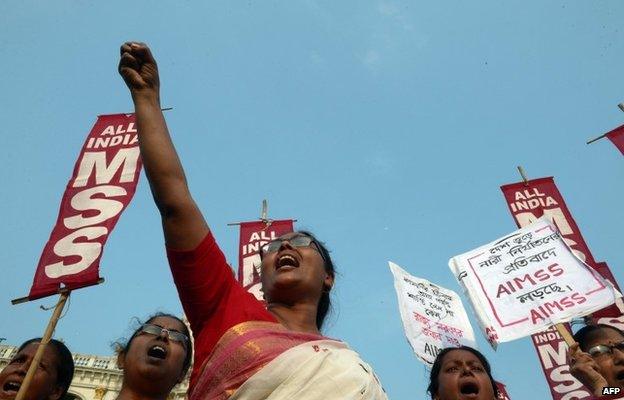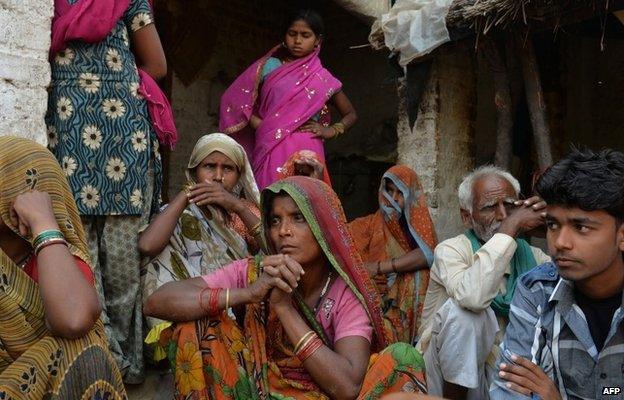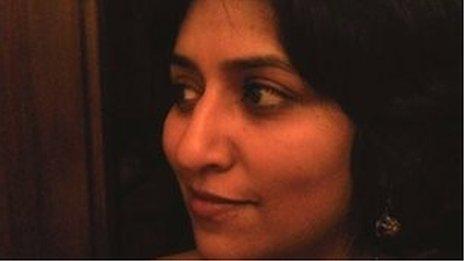Viewpoint: India must stop denying caste and gender violence
- Published

The outpouring of public anger over the deaths marks a return to the reporting of gender and caste violence
When I think of Badaun, the small village in India's Uttar Pradesh state near the spot where two young girls were raped and then hanged from a mango tree, one detail out of all of the horror is inescapable: their deaths were by no means inevitable.
The cousins were members of a caste grouping known as Other Backward Classes (OBC), low on the caste totem pole, which made them fatally vulnerable to the men from the far more privileged Yadav caste, accused of their rapes and lynchings.
The girls had gone out to the fields late at night as is the practice in places where there are no indoor toilets.
The simple act of going somewhere - to see a film in a city mall, to buy soap at a small-town shop - can be weighted with risk for women. Many girls and women wait until night before going to the open fields to relieve themselves, in order to avoid predators. It does not always work.
According to a Reuters report, when the girls did not come back, the father of one went to report the missing children to the police. The constable on duty slapped him and sent him away. This is the detail that cannot be forgotten.
Not isolated
If the father had not been from a less privileged caste, if the police had searched for the girls, they might have been found before their assailants hanged them from the tree on the village common.
The media frenzy around the deaths in Badaun, and the outpouring of public anger, marks a return to the reporting of gender and caste violence in India.
As terrible as the lynchings in Badaun are, this incident was not an isolated one. Nor had the killings and caste atrocities inflicted by high-caste perpetrators against lower-caste or tribal men, women and children miraculously ceased over the last four months.
The preceding months had seen their full freight of witch-burnings, caste rapes and other caste-driven acts of terror against men, women and children, domestic violence cases and dowry deaths.
But the media's attention had been fixed on the elections. There was a pause in the otherwise constant, disturbing flow of news stories on gender violence (chiefly rape).
Just as dowry deaths had been the crime that haunted India across the 1980s, rape - especially gang rape in rural or urban India - has become the crime that defines this decade. And the lynchings in Badaun, which happened at the intersection of caste, poverty and rape, might reverberate longer than many equally tragic crimes.

Communities perceived as powerless are often exposed to threats and violence
But the Badaun crimes highlighted two factors common to many similar atrocities: the refusal of the chiefly privileged caste police officers to intervene in time to save the lives of victims from less powerful castes, and the determination of the local community, however underprivileged, to force a response from an indifferent state and civil society.
In Badaun, the villagers had sat in a tight closed circle around the mango tree, refusing to let the bodies of their girls be taken down, until the authorities and the media had to pay attention.
Today, the families of the girls face threats, and rumours trying - cynically - to pin the killings on them. The assertions follow the same pattern in big-city cases of rape: the intent is to exonerate the accused men and to blame the girls' own families for their killings.
The price communities perceived as powerless pay for demanding justice is high: they are often exposed to threats and violence.
In Delhi, after the gang rape of four young Dalit (formerly "untouchable") women from the village of Bhagana, about 80 families fled the village and camped in the heart of the capital , externalalong with the rape survivors, determined to tell their story.
Entrenched indifference
Almost every major caste atrocity of the last four or five years that has been covered by the media has followed a similar pattern: locals going on strike, or blocking the roads, often leaving jobs and wages they could ill afford to abandon, in order to fight for some sort of redress.
The Bhagana families face entrenched indifference. The chief minister of Uttar Pradesh, Akhilesh Yadav, sparked outrage, external when he asked a woman reporter why she cared about the Badaun lynchings: "It's not as if you faced any danger?"
His remarks were as revealing as they were reprehensible. Indians who are not directly at risk of harm - protected by the privilege of caste, affluence or power - are not expected to care about those who lack these protections.
India has a long history of overlooking or dismissing the deliberate sexual violence inflicted on women in religious riots, and an equally long history of ignoring the torture, lynchings and murders of men, women and children from less privileged castes across the country.
One of the most horrifying aspects of the Badaun crimes is how normal they are, fitting the general pattern of caste crimes.
The National Crime Records Bureau (NCRB), external records crimes against scheduled castes and scheduled tribes - the most disadvantaged groups - in a separate category.
These crimes are grievously under-reported, but even so the figures for 2012 are revealing: 651 cases of murder, 3,855 cases where people were hurt, 1,576 cases of rape, 490 cases of kidnapping and abduction, and 214 cases of arson.
The need to end the collective denial is urgent if the country is to acknowledge just how widespread the epidemic of violence is, and how savage the caste and gender wars have become. Those at the receiving end of the ropes and the flames are so often the poorest, the most marginalised, the most profoundly silenced.
In Delhi last week, the families from Bhagana were briefly evicted from their place of protest. The police had been casually violent; a complaint alleges that the protesters, many of them women, were beaten and sexually assaulted by police officers. After some negotiation, they were allowed to continue with the protest.
"We can't go back to our village," Mr Ved Pal Tanwar, one of the Bhagana villagers, said. "It isn't possible. It isn't safe. But we have to keep telling our story until something changes for our community."

Nilanjana S Roy

Journalist and literary critic
Author of two novels - The Wildings and The Hundred Names of Darkness
Columnist for The New York Times and Business Standard
Edited a book on Indian food writing
